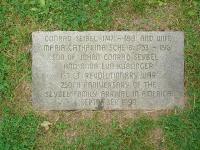Conrad Seipel
ID# 1696, b. 25 November 1747, d. 18 November 1813

Marker for the grave of Conrad Seibel, Revolutionary War veteran. The marker is at the edge of the parking lot of the Easton Public Library in Easton, PA. Photo taken by Roy Siple.
- Father: Johann Conradt Seybel b. c 1715, d. b 1782
- Mother: Anna Eva Kueblinger b. Nov 1718, d. May 1805
- Occupation*: Conrad Seipel was Cordwainer at Easton, Northampton County, Pennsylvania.
- Religion*: Conrad Seipel and Maria Caterina Scheib were Dutch Reformed.
- Birth*: Conrad Seipel was born on 25 November 1747 at Reindurkheim, Kries Worms, Regierungsbezirk of Osthofen, Germany, Age listed as 45 and over at 1810 Census.
- Immigration*: Conrad Seipel immigrated on 9 September 1749 to Philadelphia, Pennsylvania. On the ship St. Andrew, with his parents, from Germany by way of Rotterdam and Plymouth, England.
- Marriage*: Conrad Seipel married Maria Caterina Scheib circa 1772 at Franconia Twp., Northampton County, Pennsylvania.
- Milit-Beg*: Conrad Seipel began military service on 12 May 1777 at Franconia Twp., Philadelphia County, Pennsylvania, Revolutionary War, First Lt. Philadelphia County Militia, Franconia Twp. Unit. Probably participated in the battles of Brandywine and Germantown before the Valley Forge encampment (Siple letter).
Revolutionary War, 1st Lt. Fourth Co. Fifth Battalion, Philadelphia County, PA Militia, citing Pennsylvania Archives, Second Series, Vol. XIII, p. 604 (Siple SAR App.)
Revolutionary War, First Lieutenant, First Battalion, Second Company, Philadelphia County, PA Militia (PA Archives).
According to the Seiple Line, he was a First Lieutenant under Captain John Cope, Second Company, First Battalion, later Fifth Company, Sixth Battalion. His company was engaged in the Battle of Brandywine.
* * * * *
The following is quoted from the Seiple Line, pp. 10-12.
Battle of Brandywine to Winter at Valley Forge
Conrad Seiple as 1st Lieutenant of the 2nd class,
2nd Company (Franconia Militia)
1st Battalion (Philadelphia County Militia)
At first the milita was organized simply for home defense. They lacked training and discipline and were prone to desert when thrown into open encounter with the enemy. Although they were able bodied and hardy individuals, better suited to unorganized warfare. So a regular body of militia was ordered to be created. Pennsylvania counties were divided into districts of not less than 680 men fit for duty with 8 companies to each district. Field officers were elected and commissioned May 6, 1777. This is when Conrad Seiple is first listed, with 10 men under him. The companies were to be exersized 10 days each year and were thoroughly trained.
The British, determined to capture Philadelphia, advanced from Chesapeake bay up the Elk River and over land to Kennett Square. Washington planned to stop them from crossing the Brandywine Creek in September 1777. At this battle, considered a major one in the War of Independence, the Philadelphia County milita with 1000 men under the command of General John Armstrong, constituted the left wing of the defense. They covered rough ground as far south as Pyle's Ford, manning both sides of Wilson's Run. This area was considered easily defended. The main battle took place at Chadds Ford although Lieutenant Col. Reed of the 1st Militia Battalion was reported to have had his horse shot out from under him.
After losing this battle and a reported 1000 of 12,000 men, Washington's army and militia fell back to Chester (where Washington wrote his account of the battle) and then to Germantown to stop the British from crossing the Schuykill River. The Philadelphia Militia were able to stop the Red Coats from crossing the river at Swede's Ford (Norristown).
On September 16, 1777 the battle at White Horse Tavern, Chester County took place and the British entered Philadelphia unobstructed. In October the Americans were again defeated at the Battle of Germantown after which the militia had guard duty along the Schuykill from lower Montgomery and Chester Counties to the Delaware Rivee. They were to interfere with British supplies and communication across the river. Near the end of October the battle of Whitemarsh, a skirmish only, was conducted, at which time the militia "annoyed" the enemy at Chestnut Hill and received a commendation from General Washington for bravery.
While the army was at winter quarters at Valley Forge in December 1777, the militia was sent to skirmish with maurading parties of British soldiers in the countryside. this type of warfare was much better suited for them.
In January 1778 the time of service in the field expired for the Philadelphia County militia and their duties were assumed by militia of other counties while these men returned to their homes and farms. For Conrad Seiple this was Franconia Township.
Conrad Seiple is again listed in returns for his Company in December 1778. - Death*: Conrad Seipel died on 18 November 1813 at Easton, Northampton County, Pennsylvania, at age 65.
- Burial*: Conrad Seipel was buried after 18 November 1813 at German Reformed Cemetery, Easton, Northampton County, Pennsylvania.
Family: Maria Caterina Scheib b. 28 Feb 1753, d. 2 Feb 1816
- Marriage*: Conrad Seipel married Maria Caterina Scheib circa 1772 at Franconia Twp., Northampton County, Pennsylvania.
- Susanna Seiple
- Maria Christina Seiple+ b. 8 Apr 1773
- Anna Catharine Seiple+ b. 14 Sep 1773, d. 23 Jul 1869
- Henry Seiple+ b. 29 Sep 1776, d. 12 Jan 1862
- George Adam Seiple+ b. 26 Jul 1778, d. 2 Sep 1828
- Eva Seiple b. 4 Mar 1780, d. 1846
- Jacob John Seiple+ b. 3 Jun 1781, d. 23 Aug 1844
- Conrad Seiple+ b. 7 Oct 1783, d. 29 Mar 1858
- Anna Margaretha Seiple+ b. 19 Oct 1785
- John Sciples+ b. 8 Aug 1787, d. 12 Aug 1837
- Maria Elizabeth Seiple b. 1 Jan 1790
- Hannah Seiple+ b. 23 Aug 1794, d. Aug 1876
- Anna Seiple b. 7 Nov 1798